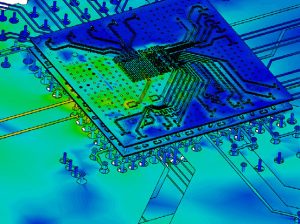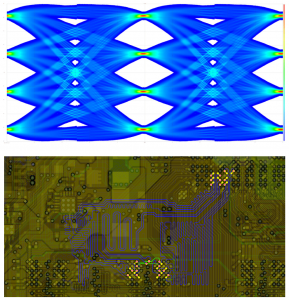5 Applications for CST Studio Suite to Improve Electronics Design
With the increased capacity of high-frequency electronic devices, EM simulation is critical to the development of new devices.
The observation that technology continues to grow at exponential rates is a bit clichéd, but it also has a name: Moore’s Law. Back in the 60s, Gordon Moore, the CEO and co-founder of Intel, posited the number of transistors on a dense integrated circuit board would double roughly every two years. That law held true for over fifty years, and while it might be slowing down, those within high tech industries are still engaged in an intensely competitive race to provide ever more powerful and innovative devices.
For businesses striving to stay at the leading edge of their industry, few tools could be more important than the advanced EM simulations provided by CAE programs such as CST Studio Suite. Here are five use cases for this technology in electronics design.
1. Model effects of increased capacity for data processing and storage.

Simulated surface current distribution across
PCB & package with CST Studio Suite.
One of the most obvious applications for EM simulation is in the design of new electronic components for data processing and storage. Despite the improvements made year after year in this area, the demand for faster, more powerful devices with longer battery lives has yet to slow down. This is because, as devices provide more processing power and increased storage, the demands placed on them increase.
EM simulation can drive improvements by showing how reduced chip sizes have increased speeds and power density. It can then help engineers understand how to use these efficiencies in their designs to provide greater capacity to end users.
2. Improve antennae efficiency to reduce coupling issues.
Although the average consumer doesn’t think about it much, antennae have become ubiquitous components among modern connected devices. The typical smartphone, for instance, doesn’t just have one antenna—it can have over half a dozen. These include antennae for WiFi, Bluetooth, GPS, and as many as four for LG cellular connectivity—and that’s just what’s in a smartphone.
Having so many components in such close proximity to each other all trying to send and receive signals causes many issues, with stronger signals drowning out weaker ones—much like too many speakers in a small room talking over each other. However, EM simulation can help engineers overcome this challenges by modeling which placement of antennae and compact isolation features within the device leads to the best performance.
3. Simulate electromagnetic interference on other electronic components and nearby devices.

CST simulates crosstalk & ISI on memory modules.
Antennae aren’t the only electronic components that can run into interference issues. With electrical or electro-mechanical systems enhancing or replacing mechanical systems in more and more industries—including manufacturing, aircraft, and automotive vehicles—ensuring that these systems don’t undermine each other is essential to maintain peak performance.
EM simulation can help engineers understand the effects of electromagnetic signals on their designs, and test possible ways to reduce interference. These simulations can be for the electric components within the device itself, and the effects that external devices might have on the system.
4. Model effects of electromagnetic influences on the human body.

A model to test an 8 channel head coil, including the magnet bore,
the gradient coils and the HUGO voxel model.
High levels of electromagnetic radiation manifest themselves quickly in the forms of burns or rashes. These come from ionizing sources of radiation, such as X-rays or gamma rays. The effects on the human body of non-ionizing sources of radiation—such as what are found in electronic devices—are currently under study. While scientific studies over the past thirty years have not shown harmful effects of exposure to low-level EM radiation sources, they have also not conclusively ruled out the possibility.
EM simulations can aid this research by modeling the effects of EM radiation on human tissue without exposing any human beings to actual risk. EM simulation can also help device manufacturers by showing that their devices fall within the regulatory standards set for non-ionizing radiation.
5. Understand the thermal effects of high powered devices.
High-powered electronic devices generate heat, and this heat can damage the electric components with a device if it is not managed carefully. Designers of high tech devices need to understand the thermal effects of the placement of components within the device so that they can make the appropriate tradeoffs between heat management and the efficacy of various components.
Multiphysics simulations that can combine the results of EM simulation from CST Studio Suite with thermal dynamic simulations can help engineers make informed decisions about the design of their devices.
EM simulation helps businesses create powerful, durable electronic devices without compromising on design or safety.
Clearly, EM simulation plays a crucial role in the designing of effective electronic devices. However, simulation doesn’t just provide the reassurance that electric devices will meet design specifications—it gives businesses the ability to push their designs further, to test the boundaries of current performance limitations, and perhaps even exceed them.
CST Studio Suite provides the software package engineers need to create these designs. As a high performance 3D EM analysis program, it provides the electromagnetic field solvers that can be used in each of the applications we have described here—and more.
For many businesses, expanding their simulation capabilities means hiring new engineers who specialize in the field of electromagnetic simulation to handle the extra work load. We can work with your engineering department both as value-added resellers of CST Studio Suite, and as CAE consultants to help you manage high volume workloads.
If your business wants to begin using CST Studio Suite to improve your electronics design, contact us right away. We’ll help you get started.

 Blog
Blog